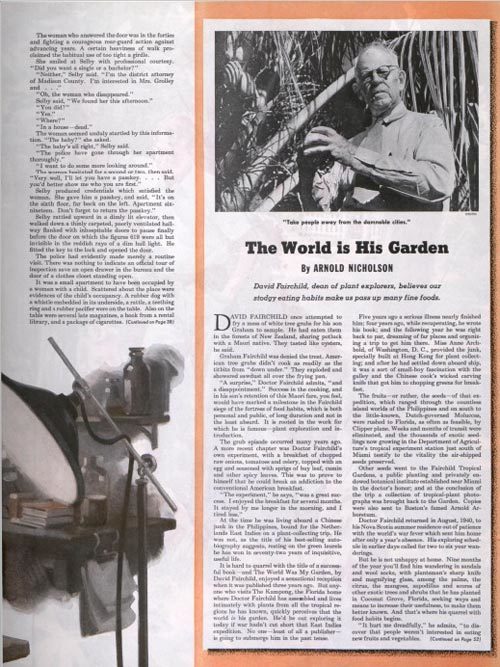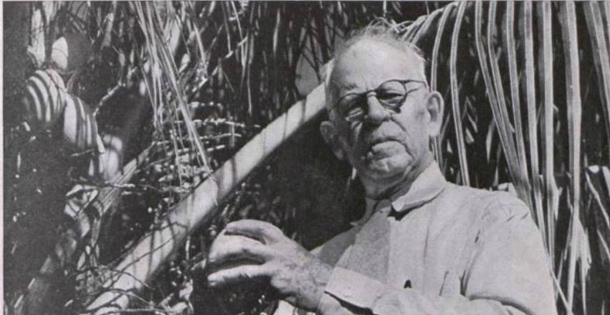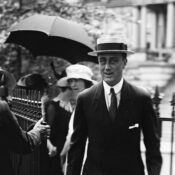If you had something delicious for lunch today, you likely have David Fairchild to thank for it. Because of him, your diet now includes avocados, quinoa, kale, nectarines, pistachios, cashews, hummus, soybeans, and varieties of mangoes, among other imported foods. You’re also drinking better beer because of superior hops that Fairchild managed to get out of Germany despite its ban on their export.
Not bad for someone you’ve probably never heard of.
In the early 20th century, David Fairchild introduced over 200,000 foreign plants to America. Though many of them never caught on, quite a few became staples of the American diet.
Food in the U.S. during those early decades was bland and monotonous, says Daniel Stone, author of the recently published biography of Fairchild, The Food Explorer.
“For generations, farmers grew little more than corn, wheat, oats, apples, and some tomatoes,” Stone told us in an interview. “Very few of our foods [today] are native to North America.”
The diversity of our current diet is the result of the Department of Agriculture’s search for new and better crops for farmers. In 1898, it opened the Office of Seed and Plant Introduction and made Fairchild its director.
For years, he sailed the world, hiking into the backcountry of distant lands and enduring primitive conditions, disease, and near-death experiences, all to find promising foreign plants and new varieties of crops that America already farmed.
The avocado is a good example. Americans knew about them before the 1890s, but they weren’t part of the national diet until Fairchild sent some Peruvian varieties to Washington, which promoted them to farmers and consumers.
“Fairchild talked about two phases of introducing foods,” Strong said. “First, there was getting farmers to grow the food. And then the challenge of getting people to buy the new foods, eat them, and buy them again.”
Many of Fairchild’s discoveries failed to catch on because they were too unusual for American tastes; others proved impractical for farmers.
“His biggest disappointment was the mangosteen, which is not at all related to the mango,” Strong said. “He thought it was the queen of fruits. But it’s a very weak fruit — there’s not much to it, it ripens quickly, bruises easily, and can’t be shipped long distances.”
Alongside the disappointments were the unexpected, and sometimes delayed, successes. “Fairchild found quinoa in Peru,” Strong said. “He didn’t know what to do with it back in 1898.”
In his book, Strong writes, “It was crunchy and fine, and had a confusing glow. No one knew what part of the plant one should actually eat: its leaves — as with its botanical cousin spinach — or its grain, which were its seeds.”
Quinoa languished until 2005, when scientists recognized this superfood as a source of protein as well as all nine amino acids the human body can’t produce on its own — all without a trace of gluten.
“Suddenly it’s the food of hipsters,” Stone told us. “And the price triples.”
Fairchild had another delayed success. Stone told us, “He would be surprised at how much hype kale has received.” When he came across it in eastern Europe, it was considered cheap food that only peasants ate. Not until the 1990s did we learn that kale has more iron than beef and more calcium, iron, and vitamin K than any other plant.
Fairchild was also instrumental in developing the citrus-food market in the U.S. Traditionally, Americans didn’t eat tropical fruit. But with other agents of the Office of Seed and Plant Introduction, he introduced marketable varieties of mangoes, lemons, and navel oranges. As a result, Strong said, “we eat a lot of tropical fruit, year-round.”
In 1941, the Post’s sister publication, The Country Gentleman, published an interview with Fairchild. Looking back over his career, he said, “There are scores of tropical and subtropical fruits just as good, even better than fruits we know; but we humans are in too much of a diet rut to create a market for them. After all, the body’s first consciousness is of taste; and so, as children, we acquire food prejudices.
“Even if they won’t eat strange fruits,” he mused, “I wish people would be as curious about plants and other living things as they are about themselves.”
You can learn more about Fairchild in Daniel Stone’s book The Food Explorer: The True Adventures of the Globe-Trotting Botanist Who Transformed What America Eats. It’s a fascinating tale full of horticulture, adventure, travel, American history, international relations, and the limits of human endurance. Learn more about it at www.danielstonebooks.com.

Featured image: Pinto for the November 1, 1941, issue of The Saturday Evening Post. (©SEPS)
Become a Saturday Evening Post member and enjoy unlimited access. Subscribe now




Comments
Thanks for your article Jeff and including this 1941 feature. No matter what decade, those old Post issues have plenty to say in the present beyond just the beautiful covers.
It took me awhile to read the feature, but was glad I did. This nation owes David Fairchild a lot regarding our food and selections. I think he would be horrified but probably not surprised at the nightmare so much of our food and drink has become with genetic modification, all the chemicals, injecting animals with hormones for corporate greed and so much more.
This is why I’m sticking with Sprouts for organic and natural foods, drinks and vitamins. You’ve got the quality and selection of Whole Foods, but at VERY reasonable prices. I’ve basically dropped Trader Joe’s as well, as good as they are.